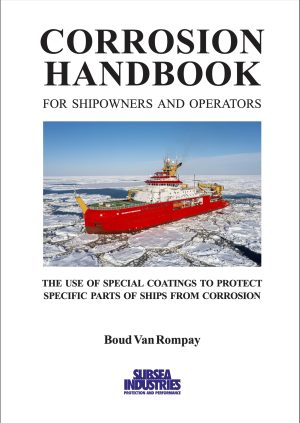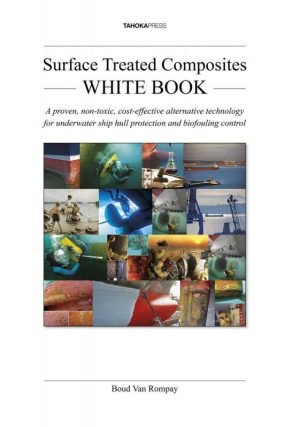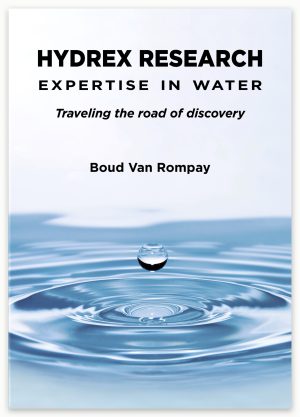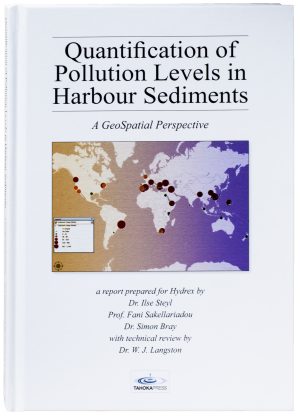The Corrosion Handbook
Author: Boud Van Rompay
The Corrosion Handbook for Shipowners and Operators – the use of special coatings to protect specific parts of ships from corrosion has just been published.
In just 54 pages with many photos and illustrations, the vast subject of how to protect specific corrosion-prone parts of ships has been addressed from a highly practical point of view. Solutions and experience gained over 50 years of constant contact with the underwater parts of ships and boats has been distilled and condensed so that only proven, workable methods of protection are presented for the use of shipowners, operators, officers and crew.
This book does not discuss protection of the main hull of the ship, but rather concentrates on the real trouble spots: the rudder, thruster tunnel, nozzles and other running gear that is so prone to cavitation damage; the inside of scrubbers as well as the scrubber overboard pipe and the area of the hull surrounding the scrubber outlet that suffers so badly from the highly corrosive effluent of the scrubber; the ice belt, boottop, decks, bulbous bow and other parts of the ship that are liable to suffer the effects of impact abrasion and wear; even the hoppers of dredgers are covered.
The book addresses the parts of the ship or boat that customers come to us for help with over and over again, simply because conventional hull coatings are not designed to protect these areas.
The Corrosion Handbook is a simple, practical solution to handling cavitation erosion, chemical corrosion and impact abrasion and wear, based on a large number of successful applications.
The Corrosion Handbook is only available as a hardback book. Copies will be mailed out free of charge to those interested in the subject. If you would like to receive a copy, please email hydrex@hydrex.be with your needs and a mailing address.
Surface Treated Composites White Book
A proven, non-toxic, cost-effective alternative technology for underwater ship hull protection and biofouling control.
Author: Boud Van Rompay
The Surface Treated Composites White Book is a description of a better, alternative, non-toxic, cost-effective, environmentally safe technology for protecting the underwater hulls of ships and keeping them free of biofouling. “Alternative” because it takes a 180° opposite vector to the generally used, conventional systems of painting the underwater hulls of ships with highly toxic heavy metals and biocides as a means of protecting the hulls and keeping them clean. “Better” because its standard application can reduce the cost of maritime transport significantly while greatly lowering the environmental impact of shipping.
This alternative technology begins with the premises that the marine environment should be kept clean and free of toxic chemicals which pollute the water and contaminate the sediment, that shipping should be able to operate and expand without harming or destroying the very environment on which it operates, that there is a non-toxic answer and that that answer is also the most economical way to sail.
The book is the result of 40 years of research, development, study and practical application and experience added to the wealth of information on the subject which has been researched and recorded by caring and intelligent minds around the world.
A preview of the White Book can be downloaded here. Please email hydrex@hydrex.be to buy a copy of the book.
Hydrex Research – Expertise in Water
Traveling the road of discovery
Author: Boud Van Rompay
This short book is a summary of the philosophy behind the activities of Hydrex Research, showing why it is different and so effective. Boud Van Rompay stresses the importance of independent observation and of persistence in research until the problems being researched eventually surrender to the continued observation the increased clarity that this brings. The book also provides examples of the type of environmental research being conducted and covers the various fields of interest, ranging from marine pollution to hydrokinetic energy generation and innovative approaches to dredging which tackle the ever-present problem of turbidity and cleaning up contaminated sediment. The book is full of wisdom on the subject of research, and also covers the practical applications.
Hydrex Group – An Overview
The full scope of Hydrex, Subsea Industries and Hydrex Research, which together form the Hydrex Group, is summarized in this book. The key underwater maintenance and repair operations which Hydrex has pioneered and is known as the top provider for are each shown in photos and case studies. They demonstrate how Hydrex keeps ships out of drydock and in business all over the world. The full line of marine protective and performance coatings offered by Subsea Industries, as well as the underwater cleaning equipment the company provides, are outlined and clearly illustrated. Finally there is a section of the book which covers the activities of Hydrex Research, following a tradition of almost 50 years of research and innovation. This research is largely related to the marine environment and aimed at reducing the harmful impact on it of human activities.
Hydrex White Book: Quantification of Pollution Levels in Harbour Sediments
Quantification of Pollution Levels in Harbour Sediments A GeoSpatial Perspective is the result of a preliminary research project commissioned by Hydrex to quantify and map the levels of pollution in sediments around the world, with particular regard to the heavy metals and toxic substances contained in ship hull antifouling paints. The preliminary project is intended to be the precursor of a complete, ongoing inventory of sediment contamination around the world for use by environmental managers and by legislators and regulators responsible for the marine environment, its health and sustainability. The book helps answer the question, “Should we continue to use the currently available biocidal ship hull antifouling paints?”





